-
1 of 253523 objects
Two cabinets-on-stand 1660-69
Silver, cocus wood | 191.5 x 152.0 x 50.0 cm (whole object) | RCIN 35297


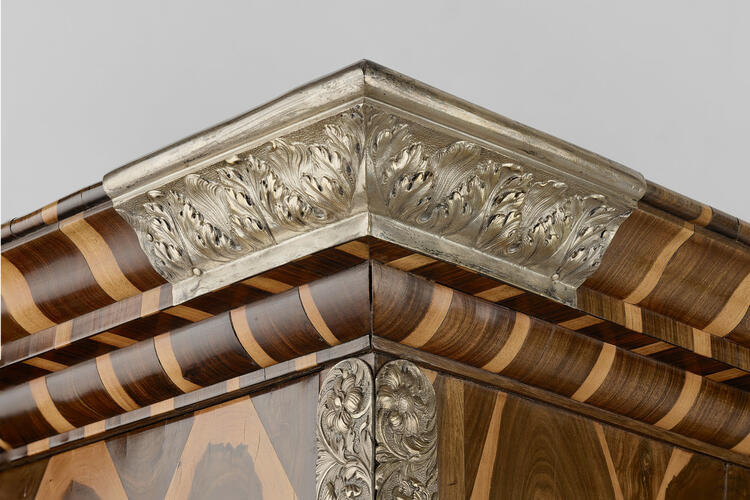
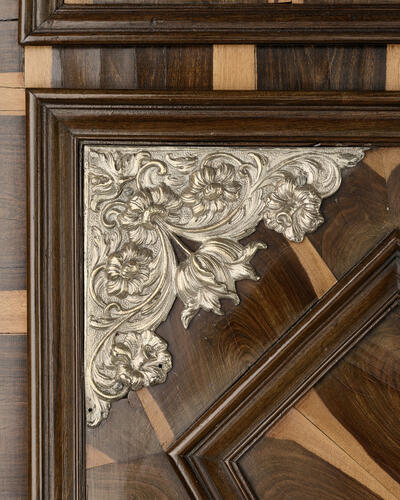
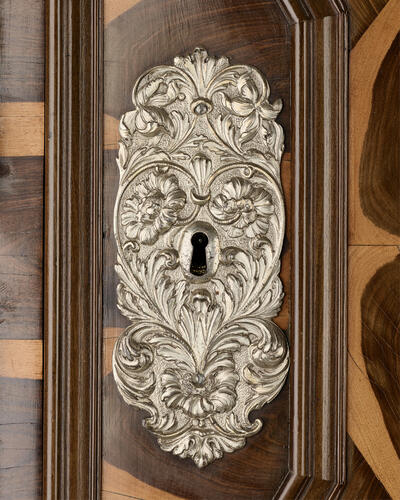
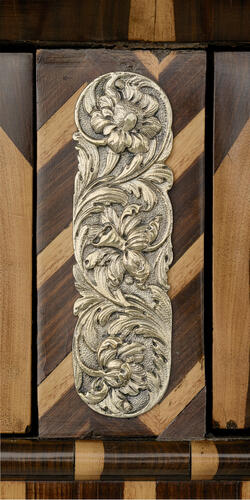
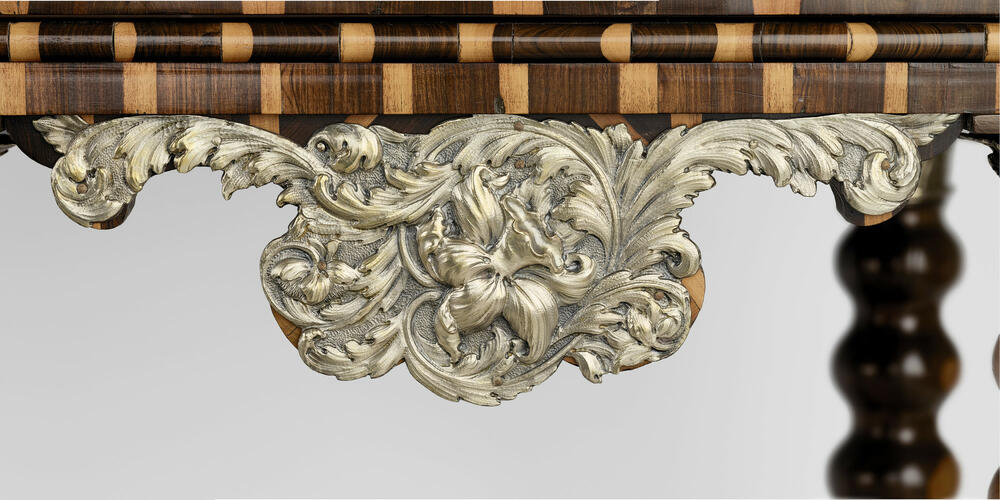
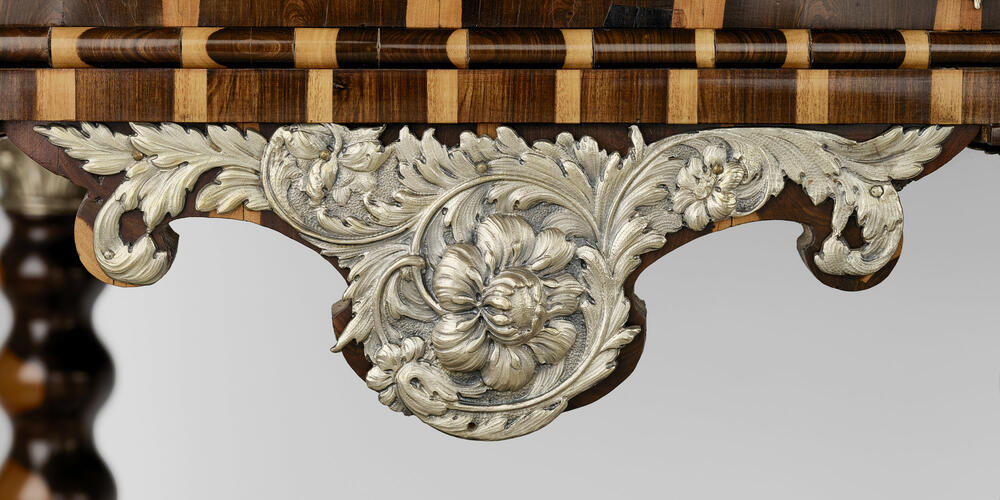

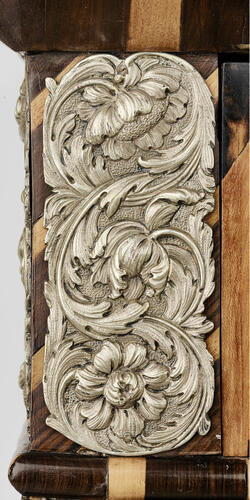
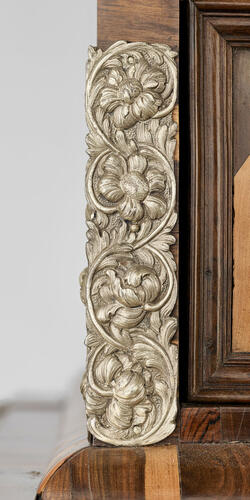

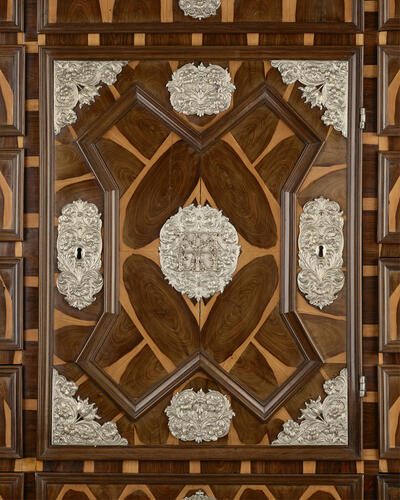
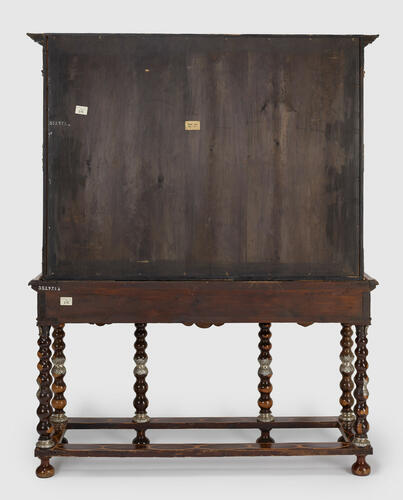
-
Each carcase made in oak and veneered in 'oyster-cut' cocus wood and with carved mouldings of the same wood. With one long drawer above eight shorter drawers around a central door, the exterior fitted with silver plaques with embossed foliate decoration, two of which also bear the cypher Queen Henrietta Maria - HMR. The central door recess vacant, probably originally with a fitted interior with drawers around a mirrored recess. The stand with two drawers in the frieze supported on six 'bobbin'-turned legs joined by stretchers.
At least one of these cabinets was almost certianly made for Charles II's mother, Queen Henrietta Maria, and probably formed part of the furnishings of Somerset House, her principal London residence after the Restoration. Both cabinets are veneered in cocus wood, a dense hardwood native to Jamaica and other islands of the Caribbean that was first imported into England following the capture of Jamaica from Spain in 1655. The striking two-colour effect of the veneer is created when the cocus wood is end cut, allowing the rich chocolate brown heartwood of the tree to contrast with the pale yellow sapwood. Both cabinets are also fitted with 88 silver mounts with repoussé foliate decoration of which two bear the queen's cipher 'HMR'.
Although at first glance the cabinets appear to be a matching or identical, pair, there are in fact minor differences in their construction and profile of mouldings that reveal the companion cabinet to be a copy of probably only slightly later date. On .1, which is the earlier of the two, the shaping of the apron and the profile of the mouldings are more skilfully executed, and the silver mounts are of noticeably superior quality. There are also differences in the number and arrangement of the oyster-cut panels on the drawer fronts and in the flower-shaped designs inside the doors. However, both cabinets are constructed with through (rather than lapped) dovetail joints, suggesting that both cabinets were produced before 1700. It remains uncertain whether .2 was made for the queen or for the subsequent owner.
While cabinets featured prominently amongst palace furnishings, there is frustratingly little evidence for their commission or manufacture. From the Restoration the cabinet maker Edward Traherne was providing the court with furniture of 'Jamaica wood', a name sometimes given to cocus wood during this period, and is known to have sold luxury cabinet ware from his shop in Covent Garden It is likely that this cabinet was made and supplied by an English cabinet maker for Somerset House where Henrietta Maria lived until her final departure for France in 1665. An inventory taken in that year reveals that there were at least seven ornamental cabinets in her apartments there, two of which were veneered in 'Jamaica wood', 'the one garnished with small pieces of fillagrim of gold and silver, Chrystall de Roch, Agat and Indian pieces'. These cabinets were later moved to the queen's houses at Colombes and Paris, where she spent the last four years of her life. The post-mortem inventory of these properties also lists a third cabinet veneered in 'Jamaica wood', although without further specification it is impossible to identify firmly any of these with the present example.
After the queen's death in 1669, .1 (and possibly .2) came into the hands of her vice chamberlain – and rumoured lover – Henry Jermyn, 1st Earl of St Albans. As one of her closest confidants, St Albans was amongst those responsible for sealing the queen's rooms at Colombes and Somerset House after her death. It has always been suggested that the cabinets were left by the queen to St Albans, but it is also possible that they were simply claimed by him at this time. As Ralph Montagu, the Master of the Great Wardrobe, remarked, 'without [the sealing of the rooms] my Lord St Albans would not have left a silver spoon in the house'.Thereafter the cabinets were moved to his country house, Rushbrooke Hall in Suffolk, where both are recorded in an inventory of 1759, the earliest confirmed record of their existence.
Text adapted from Charles II: Art and Power (2017).
Based on the variations noted above, it seems likely that the .2 was made shortly after the first was acquired by St Albans, possibly to create a pair to fit a specific room at Rushbrooke. The cabinets remained at Rushbrooke Hall until 1910, when they were sold at Christie's to Lord Rothschild and his brothers, Alfred and Leopold de Rothschild, who in turn presented them to King George V and Queen Mary in 1911, shortly after their coronation. The interior recess of one cabinet contains a printed dedication noting the gift of the cabinets from the Rothschild brothers to George V and Queen Mary.Provenance
Queen Henrietta Maria (1609–1669); probably claimed as perquisites by her Vice Chamberlain, Henry Lord Jermyn, Earl of St Albans after her death and by family descent at Rushbrooke Hall, Suffolk until sold 1910. Presented to George V and Queen Mary in 1911 by Lord Rothschild and his brothers Leopold and Victor.
-
Creator(s)
(nationality)Acquirer(s)
-
Medium and techniques
Silver, cocus wood
Measurements
191.5 x 152.0 x 50.0 cm (whole object)
Category
Object type(s)